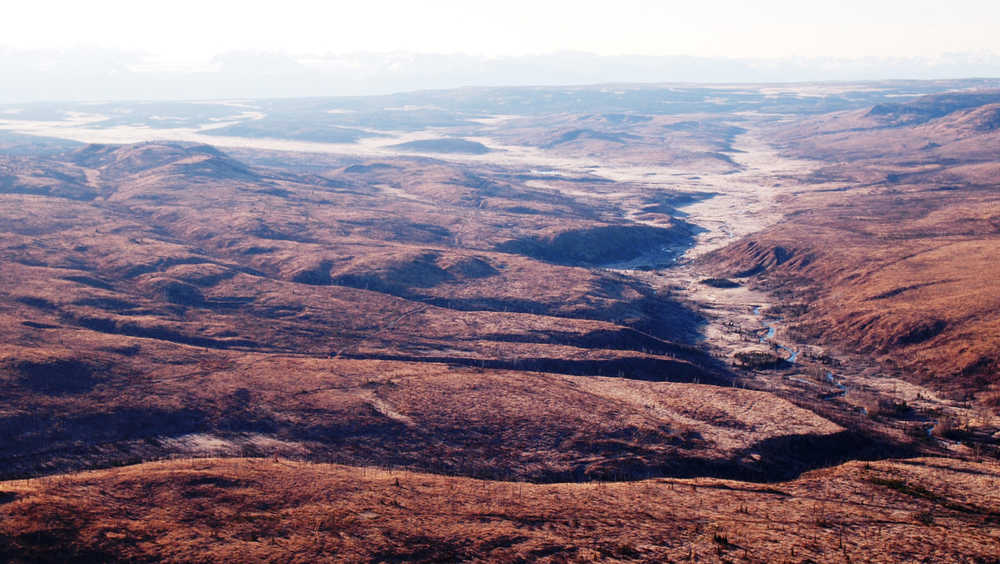Perhaps the most common plant on the Kenai Peninsula is Calamagrostis canadensis, the bluejoint reedgrass. This perennial grass grows in dense colonies near the coast and along stream banks. It has become the dominant plant on the slopes around Caribou Hills that were deforested after a spruce bark beetle outbreak in the late 1980s and 1990s. It is interdispersed among the understory foliage in both softwood and hardwood forests, tending to fill in where gaps in the canopy occur. Bluejoint was even found growing on a nunatak jutting out of Petrof Glacier in the southern Kenai Mountains!
Bluejoint’s ability to grow in widely varying environmental conditions is not limited to the Kenai Peninsula. It occurs throughout the boreal and temperate regions of North America, common in the subarctic from Alaska to Quebec, and extending southward to all but the southeastern U.S. It extends from sea level in the north to over 12,000 feet near the southern limit of its range in New Mexico.
It prefers moist sites but can survive in widely varying moisture regimes. While bluejoint cannot germinate under drought conditions, it is very drought resistant once established. It is found on both peat and mineral soils, adapted to a wide range of soil textures ranging from very acidic to slightly alkaline (pH 3.5 — 8) and is moderately salt tolerant.
What makes bluejoint so robust? Bluejoint is a sod-forming, native, perennial, cool-season grass. In Alaska, it can reach heights of 6.5 feet within 6 weeks. It readily colonizes disturbed areas especially following logging or fire, yet stands are capable of maintaining themselves for several years in permanent standing water up to 6 inches deep. Well-developed fields may persist for 100 years!
Bluejoint flowers are wind pollinated. Flowering occurs in late June or July and the seed matures in August. The tiny seeds have fine hairs attached at one end of their hull to help them become windborne, and they remain viable in the soil for up to 5 years. Prolific flowering, however, occurs only in wetlands and recently disturbed sites. Elsewhere, bluejoint can reproduce vegetatively, capable of producing an extensive network of rhizomes during a single growing season.
So why do we care? Because bluejoint growing along the urban interface greatly increases wildfire risk, likely contributing to the rapid ignition of the 2014 Funny River Fire and this year’s Card Street Fire. For many years, May 1 was the official start of the Alaska fire season, but it was changed to April 1 in 2006 largely because of the increasing threat of “pre-green up” grassland fires in the aftermath of the spruce bark beetle outbreak on the Kenai Peninsula. The year before, in 2005, the Tracy Avenue Fire near Homer started on April 29, burning 5,400 acres in what was described by the Division of Forestry’s director as the “earliest large complex fire in the state’s history.”
Since then, the peninsula experienced three other grassland fires that burned significant acreage. The Caribou Hills Fire began in June 2007 when sparks from a shovel being sharpened by a grinder ignited dry grass, eventually burning 55,400 acres and almost 200 cabins, homes and outbuildings. The 260-acre Homestead Fire near Clam Gulch burned 260 acres in May 2008. The Mile 17 Fire near Homer torched over 1,000 acres and 8 structures in mid-May 2009 after a downed power line ignited dry brush.
What these fires have in common is they were human-caused and started in grasslands, composed primarily of bluejoint, during spring. Much of what was mature white and Lutz spruce forest on the southern peninsula is now bluejoint grasslands with few spruce seedlings. This has prompted our local fire management community (All Hands/All Lands) to evaluate different treatments for reducing bluejoint in the wildland-urban interface.
As with most things in life, there is a silver lining. Bluejoint is forage, particularly when young and succulent, for livestock in Alaska and as an important food for bison in the Northwest Territories. Elsewhere, deer graze lightly on bluejoint but elk feed heavily on it during winter. Here on the Kenai, John Oldemeyer and his colleagues at the Moose Research Center showed that bluejoint was fair in energy value but poor in protein content for moose.
A study coauthored by investigators with the Kachemak Bay Research Reserve showed that bluejoint, acting as a “keystone” species, reduces riparian vegetation diversity by outcompeting other native flora. On the other hand, visiting scientists from Minnesota and Washington thought our sod-forming bluejoint was preventing the rapid spread of reed canary grass, a nonnative invasive species that threatens salmon habitat in nonglacial streams. Within headwaters streams of the Kenai Lowlands, Baylor University researchers found that decaying bluejoint litter provides the carbon input that increases the abundance and diversity of aquatic macroinvertebrates.
All of these uncommon attributes make for a very interesting albeit common plant. In our rapidly warming world, it appears to be spreading on the Kenai, filling in right-of-ways and slowing regeneration of our burned and beetle-killed spruce. You may as well get to know it.
John Morton is the supervisory biologist at Kenai National Wildlife Refuge. Find more information at fws.gov/refuge/kenai/ or facebook.com/kenainationalwildliferefuge.

